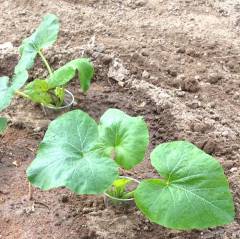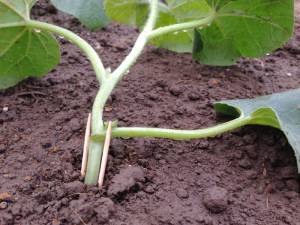Table of Contents
Cutworms
I saw the effects of these unobtrusive pests last year but didn't really understand how devastating they were. A transplant would suddenly wilt and die.
This year I became aware of them both in the garden and at the farm. As I dug to transplant and in weeding I saw numerous cutworms. Those I saw, didn't survive. But their number suggested that had many of like kind in the soil.
Effects
A cutworm chops off a tender young stem just about at ground level. The plant has no chance to recover. Whether transplanted or direct-seeded, a number of plants don't last long.
For example, of nine melon transplants at the farm only three lived long enough to bear fruit. Damage occurred over a period of time from initial transplanting to a mature plant.
Shields
This year I took two approaches. My tactic was based on the fact that a cutworm needs to wrap itself around a stem to chew around it. Sometimes this villain severs the stem, on other occasions it cuts off the flow of nutrients without completely chopping off the stem.
Plastic cup shields

 For transplants I often used a small plastic cup from which I removed the bottom. For a larger plant I cut the side of the cup to allow placing the cup into the soil and around the stem.
For transplants I often used a small plastic cup from which I removed the bottom. For a larger plant I cut the side of the cup to allow placing the cup into the soil and around the stem.
Toothpick shields
 Generally for direct-seeded seedlings I placed one or two toothpicks next to the vulnerable stem. This is enough to inhibit the cutworm's ability to chew at the stem.
Generally for direct-seeded seedlings I placed one or two toothpicks next to the vulnerable stem. This is enough to inhibit the cutworm's ability to chew at the stem.
Requirements
To provide a barrier to cutworms the shield should extend one inch into the soil and sit at least one inch above it. And it must prohibit the cutworm's ability to encircle the stem.
Results
First I compare the stems of plants with a shield with those without. The quinoa didn't have shields. None were sawed off at the ground. But there were scars around the stem near the soil suggesting that something had chewed there.
I used the plastic cups on transplants of melon, winter squash, summer squash, tomatillo, basil, and tomato. I used toothpicks on corn, some cucumbers, hoophouse tomato, eggplant and pepper.
Over the 2015 growing season I'm not aware of a successful attack indicating cutworm activity on any plant protected by either kind of shield. Given the large number of cutworms I saw as I rooted in the soil, I believe these tactics were remarkably successful.
